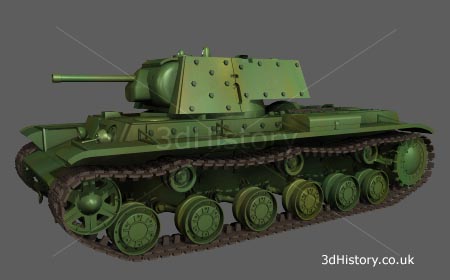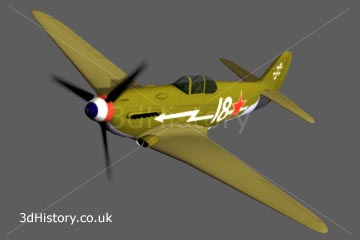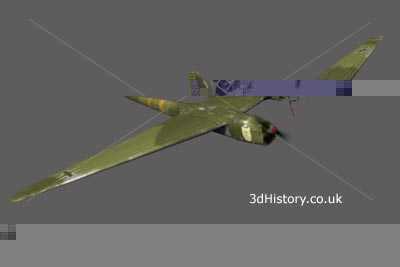The Second World War - The Eastern Front - World War Two - War Machines
The Eastern Front
The Eastern Front was created on June 22nd 1941 when Germany initiated Operation Barbarossa and invaded the Soviet Union.
Germany and the Soviet Union had co-operated in secret for a number of years before World War Two but there was a natural friction between the opposing political forces of Fascism and Communism that meant they would eventually come to blows. Germany and her allies struck first on June 22nd 1941 when over four and a half million men supported by thousands of motorised vehicles attacked along the entire length of the Axis-Soviet border.
Just as in France the German forces made rapid progress in the now familiar "Blitzkrieg" style. Soviet forces were unprepared for the attack and were pushed back before the swiftly moving mechanised troops of the Wehrmacht.
Despite the initial grand successes the Germans failed to meet all their objectives. Moscow, the Soviet capital, was the main target to elude them. As German troops came within sight of the city the Soviets launched a counter-attack that pushed them back again.
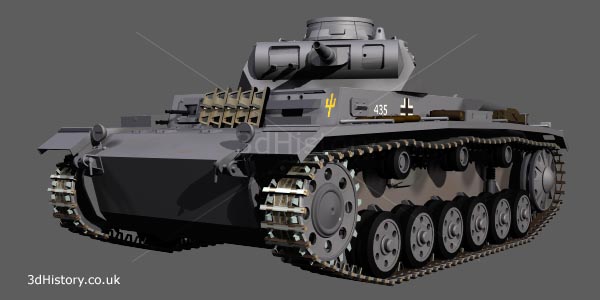
The Panzer III was the Main Battle Tank of the German Army at the outset of Operation Barbarossa. It soon became obvious that, with its 37 mm gun, it wasn't a match for the Soviet T34 and KV1 tanks. To redress this the design was repeatedly modified by fitting bigger guns and thicker armour but this didn't really solve the problem. Eventually the Panzer IV was given the Main battle tank role and the Panzer III was fitted with a short 7.5 mm gun for infantry support.
Panzer Grenadiers were infantry that were mounted in half tracks and trucks. These special units were essential in the vast open spaces of Russia for the infantry to keep up with the fast moving tanks. Without infantry support the tanks would have been easily overwhelmed by anti-tank troops.
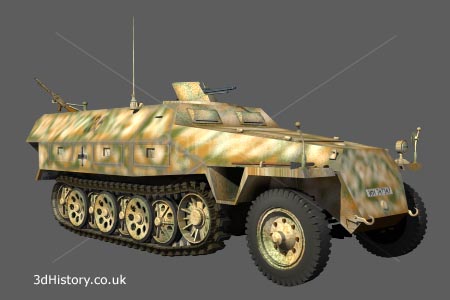
The Sdkfz 251 half track was the main armoured personnel carrier of the Wehrmacht. A half track used the front wheels for steering and the tracks for traction and load bearing. This provided a relatively cheap cross country vehicle because it didn't need the expensive and complex steering mechanisms of a fully tracked vehicle. The Sdkfz 251 was a very versatile vehicle that was used in many different roles such as rocket launcher, self propelled artillery, mortar carrier, bridge layer, communications vehicle etc.
The German offensive ground to a halt as the Russian winter set in. The German men and machines were totally unprepared for subarctic conditions and suffered badly.
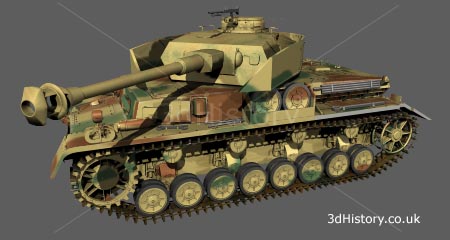
The Panzer IV was originally armed with a short 75 mm gun for use in the infantry support role. As the war progressed it became obvious that the Pz III couldn't compete with the allies heavier armour. The solution was to fit the Pz IV with a powerful long 75 mm gun and increase the thickness of its armour so that it could adopt the new role of main battle tank.
As German troops advanced deep into Russia they started to encounter two new Soviet tanks: the medium T34 and heavy KV1. These tanks armour was virtually impenetrable to the short 75 mm 3.7 mm guns of the early Pz IV and Pz III, and had wide tracks, which enabled them to operate on soft terrain and snow much better than their German counterparts.

With a 76 mm main gun the Soviet T34 was a good all round main battle tank that balanced the need for mobility, protection and firepower. It was produced in various types through the war and long after. The design introduced some innovative features: sloped armour increased the effective thickness without increasing weight, cast bodies reduced assembly times and a reliable diesel engine reduced fire hazards. The early versions suffered from cramped fighting compartments and too much work load on the commander, who had to man the gun as well as direct the tank. Later versions addressed these problems and progressively improved the type until it was fully optimised for the battlefield.
|
The KV-1 was the main Soviet heavy tank. Its thick armour was able to withstand the rounds from the short 75 mm 37 mm guns of the early Pz IV and Pz III. It was armed with the same 76 mm gun as the T34 but had thicker armour and was slower. |
|
The new Soviet armour came as a shock to the German Army. Superior tactics and communications enabled the Germans to combat the Russian tanks but it was realised that a new breed of tank was needed in the future. The immediate response was to complete a heavy tank project that resulted in the Panzer VI Tiger Tank.
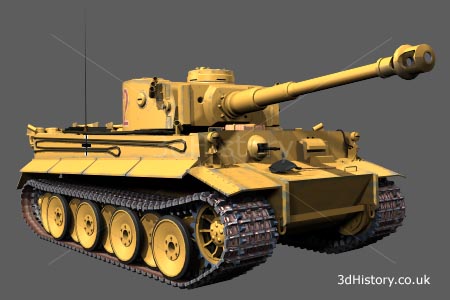
The Tiger tank was one of the most feared weapons of World War Two. It was built by the Germans in response to the Russian T34. Very thick armour and a version of the famous 88 mm high velocity anti-aircraft gun enabled it to dominate the battlefields of Europe and Africa until late in the war.
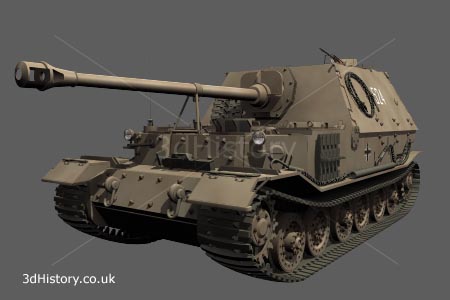
The Elefant was a self propelled anti-tank gun built on the chassis developed for the prototype of the unsuccessful Porsche version of the Tiger tank. Only 91 were built and all but two were deployed during the Battle of Kursk, where many suffered mechanical breakdowns.
Development was started on a project that called for a new medium tank to replace the Panzer IV. Ultimately this became the Panzer V Panther
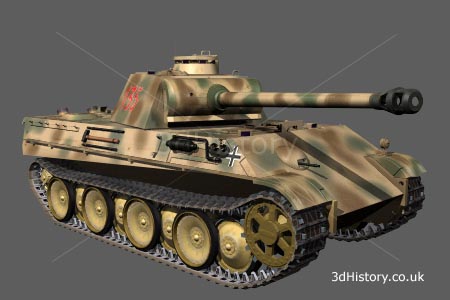
The Panzer V, usually known as the Panther, featured a powerful 75 mm main gun and thick sloped armour that allowed it to take on all but the heaviest of allied tanks. Despite early teething troubles the vehicle went on to become a successful main battle tank.
The German and Soviet use of aircraft was mainly limited to supporting the ground troops. Fighters would duel for air superiority to allow their respective bombers and ground attack aircraft sufficient protection to attack ground targets.
|
The Yak -3 entered service in 1944 and was liked by its pilots, being maneuverable and fast and, at low level, able to perform as well as the German bf109 and Fw190. It was so good in fact that German pilots were ordered not to engage it at low level. It was armed with a single cannon firing through the propeller spinner and two machine guns in the nose. |
|
Reconnaissance was an important requirement and, in the vastness of Russia, aircraft were well suited to the task.
|
|
The Fw 189 first flew in 1938. It was used in the tactical reconnaissance and army-co-operation role. It was nicknamed the "flying eye" by the Germans and served extensively on the Eastern front, providing battlefield intelligence, spotting for artillery and transporting senior officers from place to place. |
Artillery was used to soften up an enemy position ready for it to be assaulted. In order to keep up with the tanks and motorised infantry it became necessary to mount guns and rockets on to tracked or wheeled bodies.
|
The German Wespe was a combination of a 105 mm howitzer mounted on a Pz II Ausf F chassis. There was also an ammunition carrier version that didn't have the gun. The Wespe was very successful and was in service between 1943 and 1945, mainly on the Eastern front. |
|
Self propelled artillery had the advantage of being able to fire off a salvo and then quickly move to another position. This protected it to some degree from counterbattery fire.
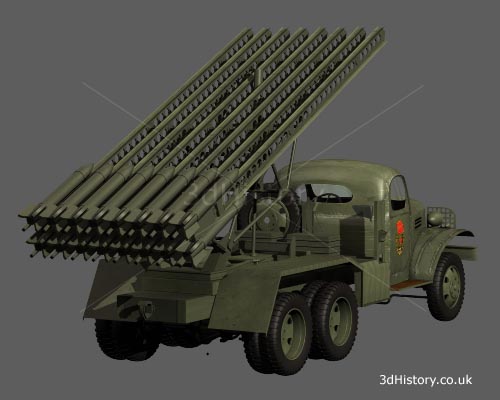
The Katyusha rocket launchers were used extensively by the Soviet Union. Rockets were cheap to produce and these launchers enabled a massive amount of explosive to be delivered to a small target area over a very short period of time.

